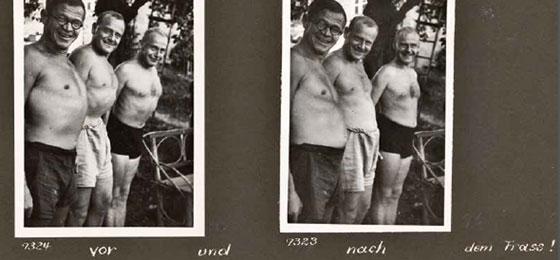Selfies: a hundred years old

After family, it’s friends who are the most popular subjects for private photography. And friendship is often demonstrated by the physical proximity of those featured in the pictures. By Caroline Schnyder
It’s almost as if they were posing for a fashion magazine. Two young women with bob-cuts and clad in brightly coloured, sleeveless dresses turn their faces to catch the sun. The taller of the two has her arm around her friend, who in turn leans on her. A mutual smile confirms that it’s all staged, signifying their playful delight in posing together. This photo from 1934 is to be found in Doris Keiser-Zanolari’s photo album. It was taken – presumably with a self-timer – on the balcony of the finishing school in Lausanne where she spent a year after high school. For the historian Nora Mathys, it is typical of the photos taken among friends in the first half of the 20th century. For her doctoral thesis on depictions of friendship in private photography, Mathys has analysed private archives held by the Swiss National Museum – 168 albums belonging to men and 65 to women. She also consulted single photos not in albums, along with photography guides and photo magazines. Her period of investigation covers the first half of the 20th century. It was a time when the new hand-held cameras became affordable to the upper classes, allowing them to take snaps whenever and wherever there was enough light to do so. The results of Mathys’s work can be seen in a beautiful book entitled Fotofreundschaften (‘Photo friendships’) that, in its composition and design, is reminiscent of a photo album itself.
Male bodily hygiene
Mathys photographed each individual picture with a digital camera and entered it in a database. Ten years ago, she says, it would have been almost impossible to carry out such a study. She took a serial approach to the pictures because it was only thanks to the sheer volume that she could identify conventions in the pictorial language of the times, and how those conventions adapted and shifted. For instance, there are many pictures of young men engaged in personal hygiene, whereas there are none of women in similar situations. And the gesture of placing one’s arm around the shoulders of a friend, common today, arises only in private photography; it was unknown in studio photography and in painting. The lead characters in Mathys’s study are men and women between 18 and 40 years from the Swiss urban upper-middle class. The topics and life phases covered in these photos are barely dealt with – if at all – in written sources of the time. The year that Doris Keiser-Zanolari spent in French-speaking Switzerland is an example of a traditional feature in the life of young girls from German-speaking Switzerland, intended to turn them into disciplined young mothers. But the surviving photos show how the girls at her finishing school endeavoured to evade the roles that had been assigned to them. But how do friendships actually become visible? How are they depicted? Whether the people in photos are friends can often only be deduced from consulting the albums, says Mathys. Friends are more likely to reappear often, in different situations in different photos. She has observed how friendship is often signified in private photos by a physical proximity that comes across as obviously more relaxed than in any studio portrait. In private photos, a degree of naturalness becomes the ideal. In the case of women, mutual physical contact remains an important means of depicting intimacy. With men such contact is rarer, and often one-sided.
Memories in perspective
The exuberance that is perceptible in the moment when those two women took their photograph on the balcony is a fundamental aspect of photography among friends, says Mathys. Playful poses and theatrical gestures can be found in many photos, and such pictures bring into perspective the function of memory that is all too often regarded as stereotypical of private photography. But friends don’t just take photos so as to remember each other or the things they’ve done together. They also do it just for the sake of it, as an act of sharing a happy moment of mutual theatricality or creativity. Photography among friends, she says, is also a means of affirming friendship and the here-and-now.
(From "Horizons" No. 100, March 2014)